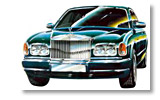
He explains that apart from the physical design itself, there is a difference in how the public perceives the new Rolls-Royce values. So Hull and his colleagues were looking at new parameters even before they decided on a design philosophy. “There were so many assumptions, we first had to take a step back and reconsider the subject,” says Hull. From the outset, Hull had always been convinced that 1955 was RR’s finest hour.
No one disagrees that the Silver Cloud, which made its debut that year, was the epitome of Rolls-Royce. “To such an extent, that some people suggested recreating the Cloud’s shape for our new model.” But Hull and his company felt a little nervous considering that idea. “It would have appealed to far too small a niche in what is already a restricted market.” Still, the Silver Cloud did play a key role in the design process of the Seraph, for its predecessor, the Silver Spirit, was still too recent for Hull to analyse.
He concluded that any Rolls-Royce should have a physical presence and, as a result, communicate through body language. The image of a yacht is the closest comparison he can draw when describing his intentions. “There you have an impressive prow, a mast and a high rear deck with an inboard cabin. It was translated in the Cloud to great effect,” Hull explains, adding that, as a result, the profile of the Cloud was almost the antithesis of the wedge.
He clearly inherited his affection for the Cloud from John Blatchley, who designed this marvellous piece of Rolls-Royce mobile sculpture and who was still working in Crewe when Hull arrived in 1971.
The article continues in Auto & Design no. 109










